I flew the Cold War Jaguar fighter-bomber

The only things that got in the way of a RAF Jaguar pilot’s survival in a potential war was a huge armada of Warsaw Pact fighters, a vast force of Warsaw Pact anti-aircraft systems, the ground… and the gung-ho friendly air defenders! We spoke to Peter Day to find out what life was like as a Cold War Jaguar pilot.
Describe the Jaguar in three words
“Comfortable, ergonomic, underpowered.
OR:
Contrived, compromised, capable.”
“Hawk missile batteries who alleged that they would have two similar piles of wreckage after hostilities, theirs and ours, so not much aircraft recognition, identification friend or foe or safety lane in use!”
Complete this sentence: The Jaguar needed…
“More development in all areas.”
What was the best thing about the Jaguar?
“Relative ease of day visual single seat operation at low level (LL).”
..and the worst?
“Lack of thrust.”
What would have been your wartime mission and how confident would you have been to survive it?

“Dual roled for Strike and Attack. Nuclear delivery and conventional ground attack from a fixed base or flank war deployments as an ‘expeditionary’ unit. The expectation was that there would be a period of Attack operations either Close Air Support (CAS), Interdiction (INT) or Offensive Counter Air (OCA) on NATO flanks or across the Inner German Border (IGB), before Selective or General Nuclear Release.
NATO flank attack operations in Allied Command Europe Mobile Force (AMF) were generally ‘on demand’ tasking against border violations, light naval forces or amphibious expeditions. Overland the Jaguar expected a high mission success to loss ratio in CAS and INT under exercise or research conditions using Operational Low Flying (OLF) and ‘lay-down’ weapons 1000lb retard or BL755 cluster weapon, shallow dive gunnery was really not sensible, see below! The combination of the Navigation and Weapon Aiming Sub-System (NAVWASS) and tactical flying could place you at an optimum weapons release point with good accuracy and minimum unmask time, although some of NATO’s flanks are pretty flat challenging exposure to defences.


The Continuously Computed Impact Point (CCIP) displayed on the bomb fall line (air-to-ground ‘live line’) in the Head Up Display (HUD) required a very short period of stable flight for accurate results. Pre-planned target positions or Target of Opportunity (TOO) designation using either ground laser marking or the onboard Laser Ranger and Marked Target Seeker (LRMTS) in the chisel nose for range calculations which greatly improved accuracy by avoiding an incorrect ‘flat earth’ trajectory calculation which caused errors.
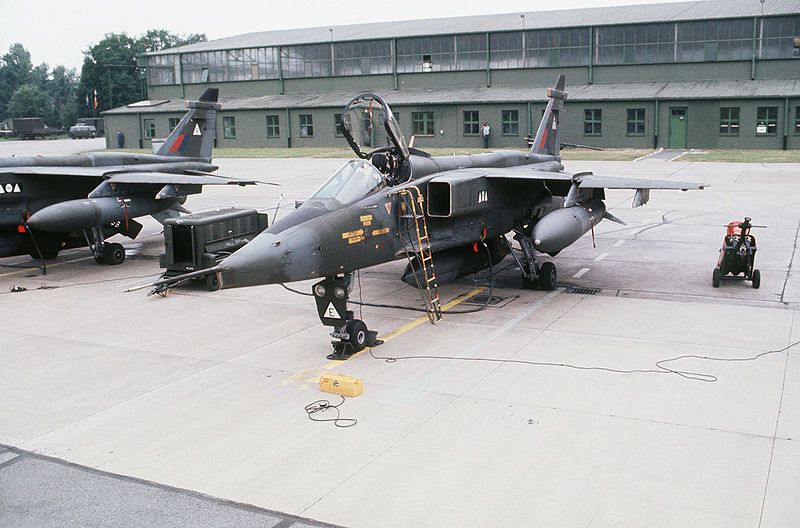
Attacks against light naval forces were always going to be high risk despite some fiendish tactics developed in conjunction with the German Navy F-104 units who would be tasked over the southern Baltic Sea, Kattegat and the ‘Belts’ various between the Danish islands, the Sound separating them from Sweden, the German mainland and Bornholm island. This was an exciting and varied ‘playground’ but very, very flat i.e. no orographic screening!
The F-104 had a good anti-ship radar but a Litton ‘tramlines only’ inertial navigation system. The Jaguar had no radar but a very good NAVWASS even allowing for some strange over-sea doppler effects from the Radar Altimeter, so the Jaguars kept the formation away from known defences and the F-104s found the target.
Perhaps the most effective tactic was the four aircraft F-104 ‘wagon-wheel’ circling out of effective ZSU-23 range above 10,000ft and using high angle dive attacks either simultaneously (exciting) from the sun quadrant in turn or 180º opposed (equally exciting). The Jaguars usually waited for a weakened landing ship target to lay-down BL755 on. Occasional high angle gunnery was considered but as all these tactics required a high cloud base other options were developed. Low-level mixed pairs of F-104/Jaguar could hide behind islands out of ship radar contact using NAVWASS and appear using F-104 radar to lay-down attack blind if necessary in sea fog or low cloud. Loosely timed co-ordinated pairs avoiding fragmentation issues did cause havoc in NATO shipping ranks during exercises.
KEEP THIS SITE GOING BY SUPPORTING US ON PATREON
IGB violation was the Central Front threat and the opposing unit was the 3rd Shock Army. There is an apocryphal statement that the only thing stopping 3rd Shock reaching RAF Bruggen was the Niederkrüchten traffic lights which were always red when you arrived. The immediate task would have been CAS but as dual-role Jaguar, other than recce (alone, unarmed and unafraid), would probably not have been committed unless a guaranteed stop was likely. Jaguar survivability over the Forward Edge of Battle Area (FEBA) was marginal at best with all the lead in the air, not to mention the forward based MIM-23 Hawk missile batteries who alleged that they would have two similar piles of wreckage after hostilities, theirs and ours, so not much aircraft recognition, identification friend or foe or safety lane in use!
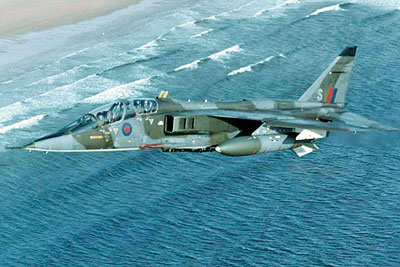
INT would be an attempt to slow the advance by interdicting supply chains, resources or river crossings all of which would be defended and reached by crossing the FEBA. Pre-planned attacks were available but at high risk due to the proximity of the FEBA. On call INT was likely if a stop was possible or the first line of defence was being overwhelmed, both possible scenarios.
OCA was also pre-planned and because of the distance behind the FEBA circuitous routing, safe lane or medium level returns could be planned. Ad hoc enemy air defence en route was ‘luck of the draw’ but airfield/missile site close defences were fairly predictable and could be minimised by approach route, attack geometry and weapons selected. Long toss ballistic delivery was also an option to avoid target overflight or exposure to close-in weapons systems.

More time had to be spent ‘red side’ and the Jaguar had quite good ‘legs’ at low level so a target 150nm+ beyond the IGB was quite feasible retaining the underwing tanks, bearing in mind RAF Bruggen was some 150nm from the likely FEBA. Simulation and Red Flag data indicated that with good pre-planning, current enemy intelligence and support missions less than 10% attrition was likely.

Strike operations involving selectable yield lay-down or loft deliveries of WE.177A were a UK contribution to the US Single Integrated Operational Plan (SIOP) in force at the time administered locally by SACEUR, either as a Selective Release (Selrel) – tailored counterforce – mission or during General Release. As a single seat day/night/all-weather (yes, as declared!) visual operator this would have been a really big ask and mission ending Controlled Flight Into Terrain (CFIT) would have been as likely as enemy air defence attrition or weapon side-effects. Flying on a forecast QNH altimeter setting, at an altitudes minus all the safety margins/percentages, IMC, relying on the NAVWASS with occasional glimpses of the ground would have been a ‘go to the end of the printed line in your route book and deliver the weapon’ scenario, if you got that far. Day VMC was doable, night or IMC would have been very high attrition.”

What were you first impressions? How did it compare with other aircraft you’d flown?
“Luckily I was awarded a Hunter course at RAF Chivenor before joining the Jaguar Conversion Unit, soon to be 226 OCU, at RAF Lossiemouth. So with minimal ground attack experience all the shiny levers were very exciting and the fleet had almost zero miles on the clock. Comparing it initially to the Hunter the speed performance was similar but manoeuvre was ‘⍺’ governed and the obvious difference in wing area told the story with reduced performance.
During manoeuvre the wings deflected up but the fuselage bent down at nose and tail causing the spine to lengthen. The control system rods which passed along the spine did not, so an input of both rudder and tailplane occurred above 4g which was undesirable! A ‘spine bending compensator’ was incorporated into the aircraft’s yaw and pitch auto stab systems to overcome this effect at high ‘g’.
Exaggerated nose-up attitudes for take-off and landing took getting used to but the handling and stability in its planned low level regime was excellent. Attack system handling could be as easy or difficult as you wanted to make it with many modes available, but the Projected Map Display (PMD) magnet and NAVWASS housekeeping caused many ‘head-in’ inattention scares and some losses. The Head Up Display (HUD) was new to the RAF and not 1:1 scaled for display size reasons amongst others, so good though it was it took a little interpreting and critical manoeuvring was better accomplished on the classic head down attitude indicator (AI) horizon e.g. loft/toss weapons delivery recovery in cloud to avoid ‘laddering’ in the HUD i.e. the rungs – attitude bars – rushing past like a waterfall and causing disorientation.”
How good were the navigational systems?
“The NAVWASS as designed was excellent give or take a couple of minor ergonomic/switch issues. Unfortunately the hardware and software were running to keep up with the plan. So much so in certain cases that when I collected a Jaguar GR1 from BAe Warton the central PMD was not fitted and I delivered it, safely, to RAF Lossiemouth staring at my feet every time I looked into the cockpit. Most of the ‘black boxes’ – primarily the Inertial Platform (IP), Platform Electronics Unit (PEU), Computer, Air Data Compute (ADC) – were quite ‘cutting edge’ technology and as it transpired liked to be ‘matched’ with each other, certainly the IP and PEU. The HUD waveform generator and projecting low light TV didn’t like firm landings, neither did the IP which often commented with a large X on the ‘frozen’ HUD. Excellent work by the avionics engineers, manufacturers and BAe gradually resolved all the issues and the ‘matching’ of LRUs had a significant effect at unit level. When the system was ok it was outstanding for its flexibility and accuracy leading to the ‘bomb in a bucket’ quote by OC 226OCU.”
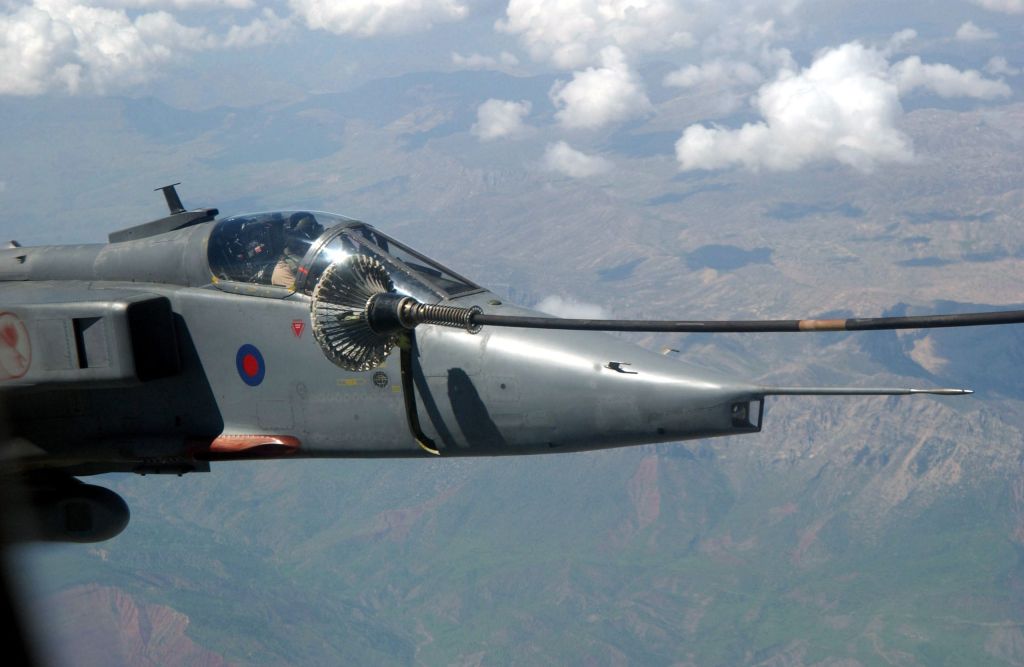
Tell me something I don’t know about the Jaguar
“Two blue land-away baggage cases were supplied by BAe with each new aircraft fitting perfectly into the gun ammunition boxes.”

Did it have enough power?
“There was never enough power and the Adour, an Anglo/French cooperation, was optimised for high take-off thrust in reheat, good specific fuel consumption, providing a high speed dash capability and was to be changeable in 30 minutes! Good job there were two. Engine improvement were forthcoming including ‘part throttle reheat’ (PTR) to improve single engine handling, arguably also survivability, allowing reheat at less than maximum engine N1 rpm. Eventual Adour marks improved all engine performance aspects but there was rarely spare power, depending on the configuration.”
How do you rate it in the following categories
Instantaneous turn rates
“Always ⍺ (12, 14, 17 depending on config) and power limited but with 450kts a 6g+ 180º break was possible with a 150kt loss. Wing area was 75% of a Hawker Hunter and it showed.”
Sustained turn
“Entirely power and configuration dependent, not good in a low level turning fight with stores loaded. Clearing the wing turns it into a supersonic trainer and it is very capable but the mission is lost. W/L of 650kg/m² was nearly triple the Hawker Hunter figure.”

Take-off/landing performance
“Landing first, easy, precise (⍺), brake parachute equipped with big brakes – excellent! Take-off has been variously described as due to the curvature of the earth and was certainly an Operations Manual reference event depending on entropy, configuration and airfield. Reliance on ‘clear wing’ after engine failure would be operationally standard. Full reheat was standard and operational formation take-offs would be a race to the first waypoint.”
High AoA performance
“Interesting, in that it had a very ‘hard’ flight envelope boundary. It flew very well up to the ⍺ limits for various configurations but beyond them, certainly dynamically, wing rock then instability in yaw and pitch led to a departure which was un-recoverable at low level, barely so at medium level with a ‘centralise’ controls recovery.”
Climb rate
“Totally weight and configuration dependent but the clean aircraft at 10 tonnes had a T/W of 0.5 similar to a Hawker Hunter, and climbed to 30,000ft in just over 1 minute. Fully war configured time to height was fairly pitiful and very fuel consuming.”
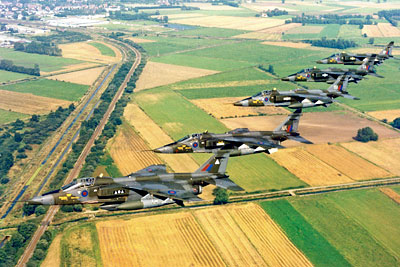
Range
“Jaguar was designed to have a good specific fuel consumption in dry power cruise and aerodynamically efficient tanks and weapons didn’t affect that too adversely at low level. Accelerating to penetration or attack speed was a reheat event, PTR helping to sustain on reaching. 300nm plus lo-lo radius of action with four weapons was quite feasible Ferry at altitude was comfortable with two and a half hours un-refuelled on external tanks; clean ferry was nearly two hours cruise climbing and exploiting the transonic aerodynamics.”
Weapons platform
“Very stable level, shallow and high angle dive and in long toss/loft although the ballistics for real weapons over long distances were a little suspect. Relatively high-wing loading assisted by good auto-stab/damping systems smoothed tracking.”
The Hush-Kit Book of Warplanes will feature the finest cuts from this site along with exclusive new articles, explosive photography and gorgeous bespoke illustrations. Pre-order The Hush-Kit Book of Warplanes here. Thank you. Our controversial merchandise shop is here and our Twitter account here @Hush_Kit. Sign up for our newsletter here. The Hush-Kit Book of Warplanes will feature the finest cuts from this site along with exclusive new articles, explosive photography and gorgeous bespoke illustrations. Pre-order The Hush-Kit Book of Warplanes here.
Combat effectiveness
“Apart from the inaccurate loft/toss (nuclear weapon kill probability resolved that) all other weapons deliveries had to overfly the target so surprise, OLF and attack geometry were critical. If the lay-down/shallow dive weapons were delivered they would hit. However, ingress/egress versus CAP fighters, area/land forces air defence and SHORAD meant that cunning planning was crucial and range consuming. Lo-lo or lo-lo-hi were the only options for survival and then the Hawks or even the ‘home plate’ CAP might get you
(F-4 Phantom 1, Jaguar 0 – 25 May 1982).
Basically a digital Hunter so it did ok and got better with age.”
Cockpit
“Roomy, good visibility, quite ergonomic with an unfriendly computer interface, the hand control was a good idea but felt very analogue. Don’t mention ‘slugging’!”
KEEP THIS SITE GOING BY SUPPORTING US ON PATREON
How affectionate did you feel towards the aircraft?
“Very as it was joy to fly, more robust than you would think and would deliver weapons with a new order of accuracy. What equipment should have been added to the aircraft? Better RWR and defensive aids. Radar of course but no hope. Lots of ‘goodies’ did arrive with the GR1A, better NAVWASS, chaff/flare, ECM and Sidewinder. TIALD laser designator pod capability, bigger, engines and aiming improvements all installed in the GR3A.”
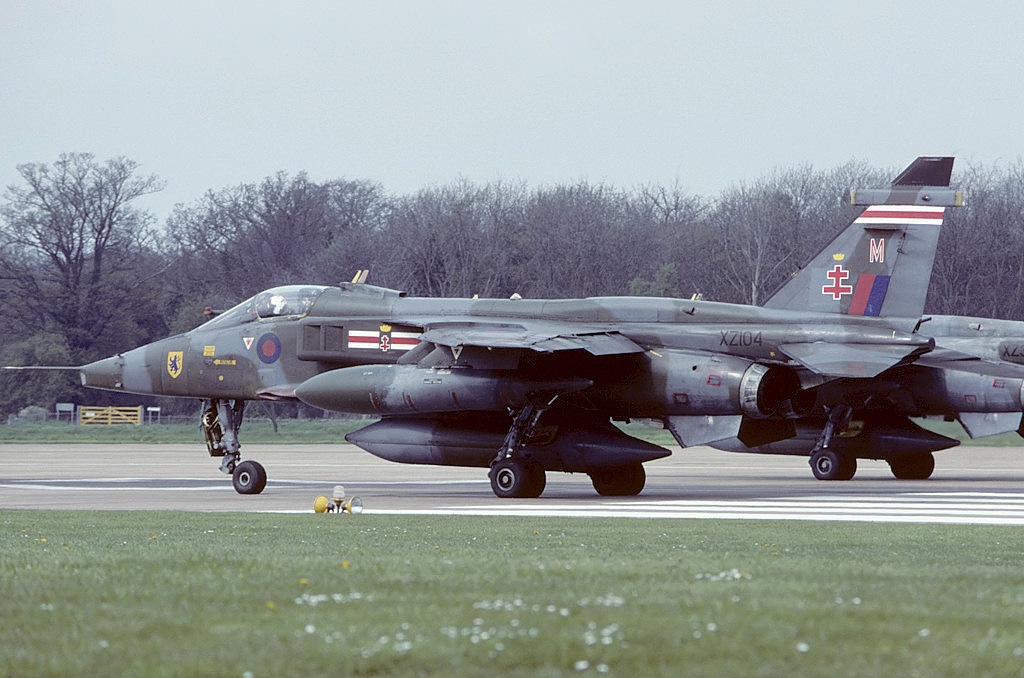
Having flown both, who would likely win in a guns-only fight between a Javelin and a Jaguar?
“Jaguar without doubt mostly due to its hit and run capability. Javelin lacked dynamic manoeuvring although the ‘shotgun’ spread of four Adens would cause havoc if they hit you.”
What should I have asked you?
“Air-to-air refuelling ✔️ Probe installation with good geometry, easy to fly but spoke the basket and the debris goes down the starboard engine, total embarrassment! A ‘one shot’ hook was fitted, good for RTOs and hydraulic failure landings. Further taxying, if possible, was accomplished with a roller skate under the ‘shoe’ or a suitable length of rope attached to the safety pin and holding the hook off the ground. Re-setting the hook was like pulling a giant longbow.
The T2 had worse high ⍺ characteristics than the GR1, mainly due to B/A ratio factors, but the FAF seemed to have a very ‘carefree’ handling regime with it, perhaps they knew something? It was not nuclear wired so was a bit of an orphan late on in war exercises. The fuel system was automatic with a French ‘fairy lights’ display for when it malfunctioned, a frequent early problem, you then had to interpret and select an appropriate switch to avoid flaming out. The excellent brake parachute in its tin container had a habit of falling out at random if poorly fitted and subject to high ‘g’ or OLF in turbulence. There are containers in the Scottish Highlands today.
Could the Jaguar have operated from an unprepared or graded airstrip? Yes – everyone had great confidence in the French designed ‘train d’atterrissage’ or ‘train’ and it could absorb all sorts of arrivals.”
What about recce? “Good question, the centreline recce pod as fitted was excellent and when it was digitally updated developed a mind of its own to produce good content despite the pilot!”
KEEP THIS SITE GOING BY SUPPORTING US ON PATREON
Jaguar Conversion Unit (226 OCU) Jun – Sep 1974
No 6 Sqn RAF Coltishall Oct 1974 – Apr 1977 ‘Flying Can-openers’
No 14 Sqn RAF Bruggen May 1977 – Aug 1980 ‘Crusaders’
HQ RAFG Jaguar Staff Officer Sep 1980 – Feb 1983
1500+ flight hours Jaguar

